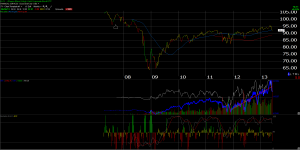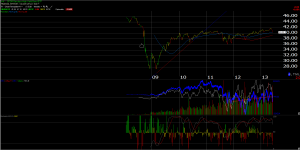

We put two weekly charts up this morning, the two corporate high-yield ETF’s, which show the junk bond market is in correction mode.
Both ETF’s are sitting right on top their respective 50-week moving averages. For both ETF’s to drop to their 200-week moving averages, would require another 2% decline.
The corporate high yield (i.e. junk bond market) is considered an early warning canary for the stock market, so it pays to watch what is happening with high yield spreads.
Despite the very low level of nominal yields and interest rates, “credit risk” is still thought to be cheap to Treasuries, which means (in English) that the spreads at which corporate credits still trade relative to the equivalent-maturity Treasury security, is still wider than what is considered “normal” or average spreads over time.
The point of the last sentence is then, is that it still pays to be overweight credit risk in terms of portfolio management. The “average weighting” for corporate high yield bonds in benchmarks like the AGG and other widely-held, fixed-income benchmarks, is 10% – 15%.
The HYG ETF has a 12-month yield of 6.5% and an SEC yield (according to Morningstar) of 4.6%.
The JNK ETF has a 12-month yield of 6.5% but Morningstar doesn’t provide an SEC yield for the ETF.
High-yield tends to outperform when the economy is gaining steam, and corporations are flush with cash, as SP 500 companies are today. The high yield market tends to be positively correlated with the stock market, in that spreads tend to widen when the SP 500 corrects, and spreads tend to narrow when the SP 500 rises (when looked at over longer-time frames).
Corporate high yield also tends to hold its value better in markets where interest rates rise, if the rate rise is driven by stronger economic growth, as opposed to inflation.
We remain overweight corporate high-yield in client accounts as we think probability is that the US economy is more likely to strengthen over the next 12 – 18 months, than to enter a recession or near recession.
We like ETF’s vis-a-vis open-ended mutual funds given that it gives us more flexibility to adjust exposure in client accounts.
If you think the US economy will continue to slowly gain strength and continue to work off the poor Washington fiscal policies, then continue to hold high-yield in your portfolio.
Trinity Asset Management, Inc. by:
Brian Gilmartin, CFA
Portfolio manager
